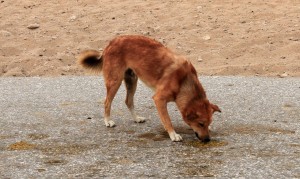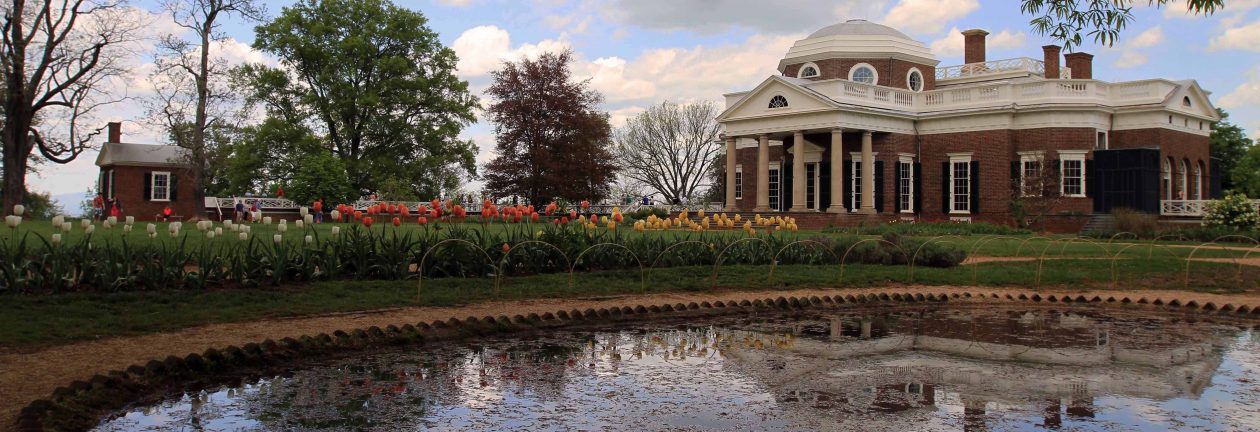Cairo, Egypt
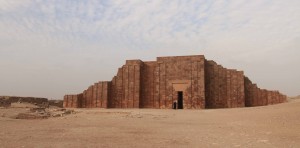
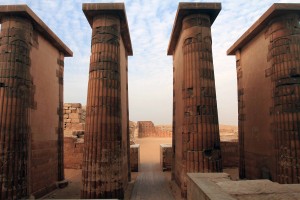
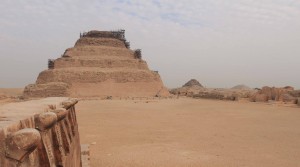
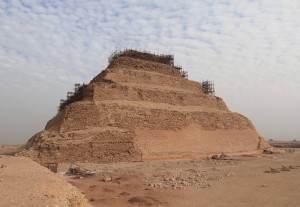
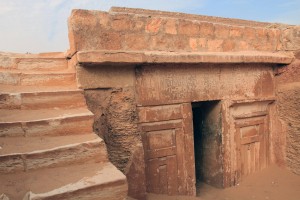
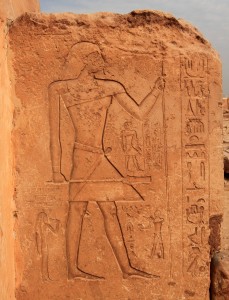
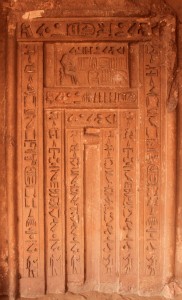
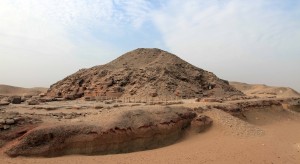
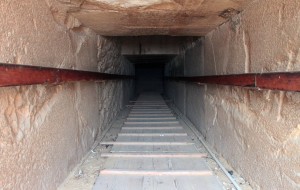

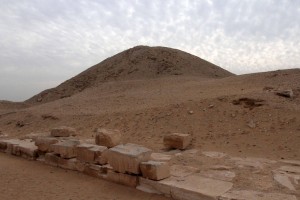
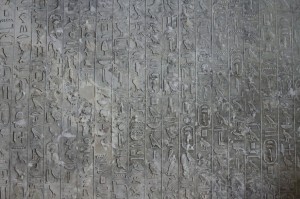
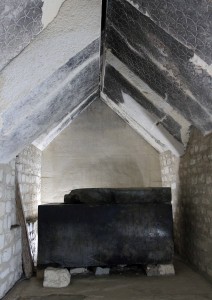
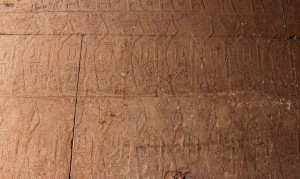
I woke up around 07:00, got ready, had breakfast (fried egg, bread with cheese and jam, and tea), and then waited for my hired taxi (arranged through the hotel) to arrive at 08:00 and take me around the pyramids. He arrived roughly on time, the hotel staff paid him, and then we drove to the North Saqqara necropolis. Upon reaching the gate at the edge of an oasis, I paid the entrance fee and then the driver took me to the Pyramid of Djoser, the famous stepped pyramid that was built during the Third Dynasty in the twenty-seventh century BC. To reach the pyramid, I walked through a roofed colonnade; I then walked up on an earthen embankment surrounded the excavated site, where I was able to get some nice views of the pyramid. I then walked south and explored the different tombs in the area and tried to enter the tomb under Sekhemkhet’s Pyramid (also built in the Third Dynasty), but it was closed; I didn’t spend too much time here because I wanted to give myself as much time as possible at Giza, knowing that it closes its gates at 16:00. I then returned to the taxi and he drove me to another part of the North Saqqara necropolis and we stopped at the Pyramid of Teti; first I walked around some of the tombs next to the pyramid and nearby where they were having an archaeological excavation before entering inside the pyramid itself; I hunched my back, descended the steep ramp, and entered in to a corridor that led to the stone sarcophagus; the walls were mostly covered in hieroglyphs and it was a cool experience (not literally, it was actually quite hot down there), but the corridor and burial chamber were smaller than I had imagined. I then turned around and exited the pyramid, and returned to the hired taxi. Next, we drove to another spot nearby, where I got out, walked by some statues of philosophers and then to the Tomb of Ti (Fifth Dynasty, 2400 BC); I entered inside the tomb complex, looked around, and crawled to the burial chamber. After exiting the Tomb of Ti, I returned to the taxi and we drove out of the North Saqqara necropolis and on to Dashur necropolis (picking up a police officer along the way – just as I witnessed in India, the police here frequently use taxi cabs to drive their lazy asses around).
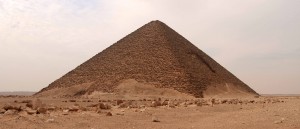
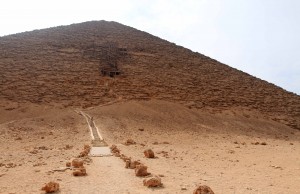
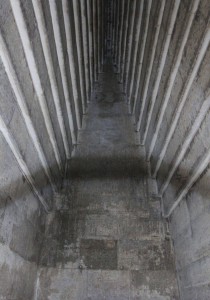
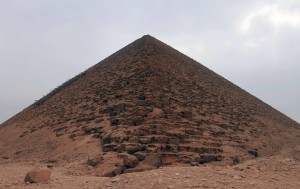
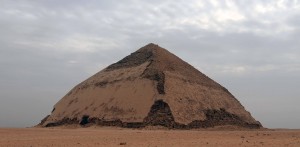
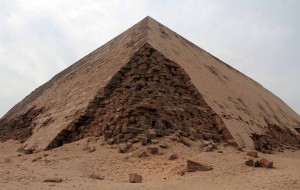
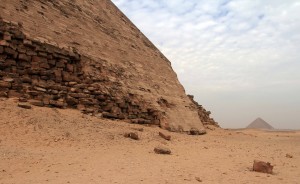
We soon reached the Dashur necropolis and drove through the gate; I purchased my entrance ticket and then we hit the road to the Red Pyramid. The Red Pyramid (also called the “North Pyramid) is the largest of the three pyramids in the Dashur necropolis and is believed to be Egypt’s first successful attempt at constructing a “true” smooth-sided pyramid; it was the third pyramid built by Pharaoh Sneferu (2600 BC) during the Fourth Dynasty; it is 104 meters high and is built at a 43-degree angle. We stopped in front of the pyramid, I exited the car, walked up the steps to the entrance, and then descended down in to the burial chamber; inside it was very hot and the air was stale, and in no time I was sweating (the steep corridor leading to the burial chamber didn’t help); I was also alone, which was a nice experience. After touring the inside of the Red Pyramid, I exited it and returned to the taxi. We then drove one kilometer south to the Bent Pyramid; the Bent Pyramid was the second pyramid built by Pharaoh Sneferu (the first, the Pyramid at Meidum, collapsed during antiquity, though its central core is still standing and could be seen from the Bent Pyramid) during the Fourth Dynasty; it started construction at a 53-degree inclination, but, once the builders realized that angle could not be maintained and that the pyramid would collapse, the inclination was altered to 43-degrees, thus giving it a bent appearance. The entrance to the Bent Pyramid was closed, but I did walk around the entire pyramid (a soldier assigned to guard the massive structure joined me – more on that later) and was able to see the satellite pyramid on its southern side that was built to house the Pharaoh’s Ka (his vital essence or spirit). After walking around the giant pyramid, I returned to the taxi and we drove out of the Dashur necropolis (other than the three pyramids built by Pharaoh Sneferu, there wasn’t much to see, but I did enjoy this necropolis more than the North Saqqara necropolis and the Red Pyramid was great to enter in to.
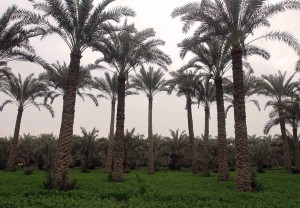
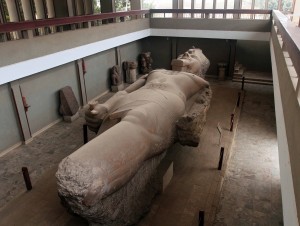
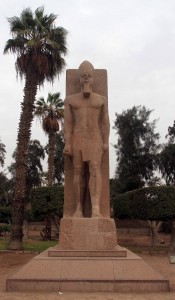
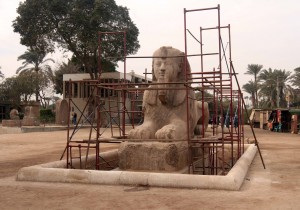
We then drove past some date palm plantations and onward to the ancient site of Memphis. There wasn’t much to see in this Memphis (the Tennessee one is vastly superior), but I bought my entrance ticket and went inside anyway. First, I walked in to a structure built to shelter a giant statue (now lying on its back) and that housed some other statues and stelae; then I walked around outside where a number of other statues, stelae, canopic boxes, and sarcophagi were displayed; the highlight of the whole place was the Sphinx of Memphis, a much smaller version of the Sphinx at Giza; this Memphis site (called the Mit Rahina museum) also had many vendors with their stalls full of cheap trinkets; all in all, it was a pathetic place with little value. I then returned to the taxi and found the driver having tea at a papyrus souvenir store; I had been warned about these places and I’m certain the driver was hoping I’d buy some overpriced garbage to help out his friend; of course I’m not buying any souvenirs on this trip and I didn’t care to look around, so the disappointed faces of the shop keepers were quite visible. Once my driver got the message that I wasn’t buying and was ready to go, he finally took his place in the driver’s seat and drove me to the Giza necropolis.
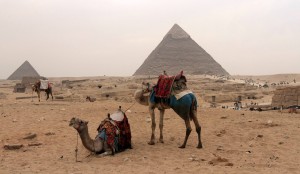
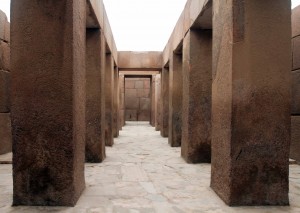
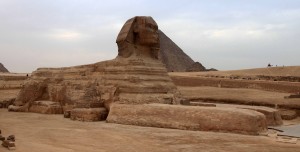
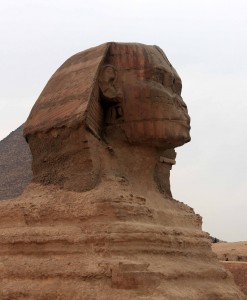
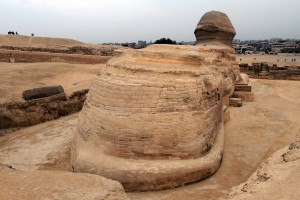
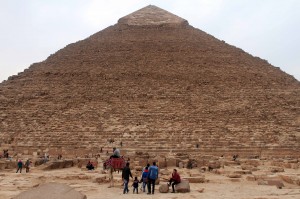
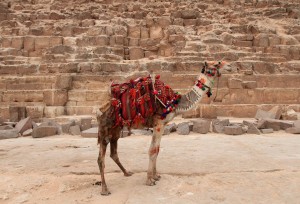
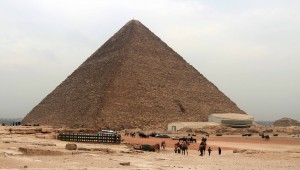
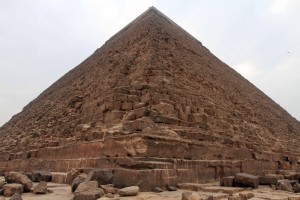
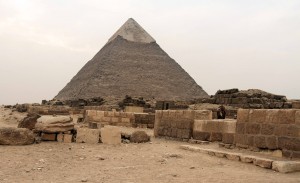
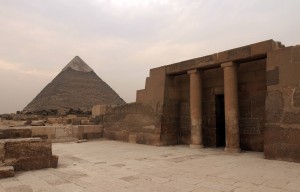
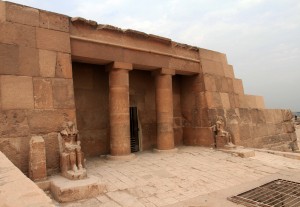
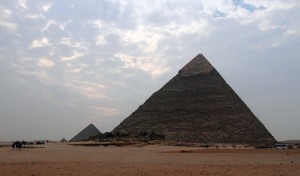
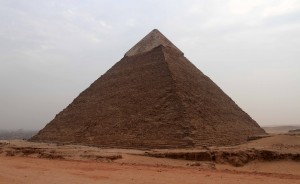
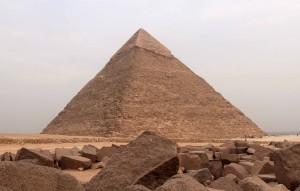
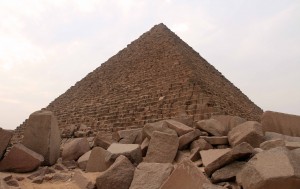
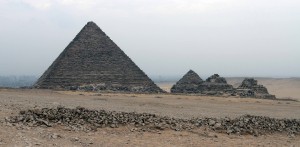
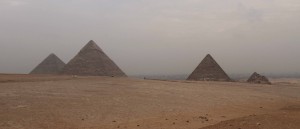
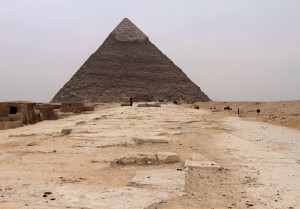
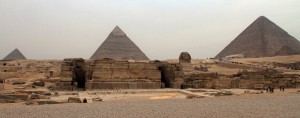
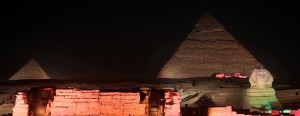


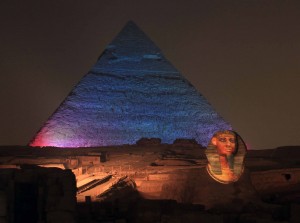
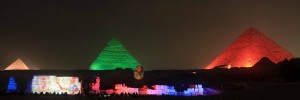


On the way to Giza, we drove through a checkpoint and were stopped and the driver was questioned; once we were cleared to proceed, my driver laughed and told me that they stopped us because of my beard – even in Egypt a beard is a sure sign of fanaticism and can be used to spot terrorists. As we neared the Giza necropolis, desperate young men were stopping the car trying to sell tickets at inflated prices; my driver warned me about these people and told me not to trust anyone at Giza since they were mostly criminals (how very true); he then pointed me to the ticket office, I exited the vehicle, gave him a tip, and then said goodbye (since I had decided to stay late at Giza for the Sound and Light Show, I had to leave my driver since he was only booked until 16:00). I bought my ticket, went through a security checkpoint that I’m pretty sure is pointless (anyone can sneak anything in to this poorly secured and terribly managed site), and then walked around inside the famous necropolis. I first walked in to the Valley Temple and then through it to the Sphinx (we could not get right up to it, but were at least offered nice views from behind the Valley Temple). Next, I walked on the causeway, following it up to the Pyramid of Khafre (also known as the “Pyramid of Chephren”); it is the second-tallest pyramid built (at a height of 136.4 meters) and is the tomb of Pharaoh Khafre (Chephren), who ruled from 2558 to 2532 BC during the Fourth Dynasty. I reached the base of the Pyramid of Khafre and then walked counter-clockwise to its entrance; I had planned to buy a ticket at the entrance to go inside, but discovered that tickets are no longer sold at the entrances to the pyramids and that I would have to walk to the north entrance of the Giza necropolis to buy a ticket (they must not want to make a lot of money here, asking guests to walk back and forth if they suddenly fancy entering in to a pyramid). I ended up walking to the north entrance since my mind was set on entering one of the pyramids here at Giza; I exited the park, walked to the ticket counter, and then bought an entrance ticket to the Great Pyramid of Giza (tickets were being sold for the Pyramid of Khafre, but I wanted to enter in to the largest one – what a retarded decision and a huge waste of money (it cost 200 Egyptian pounds to enter in to the Great Pyramid compared to 40 Egyptian pounds for Khafre’s pyramid). With my ticket now in hand, I walked to the Great Pyramid of Giza (also known as the “Pyramid of Khufu” or the “Pyramid of Cheops”), which was built between 2560–2540 BC during the Fourth Dynasty to house the tomb of Pharaoh Khufu; it stands the tallest of all pyramids at a height of 146.5 meters and is the last remaining wonder of the Seven Wonders of the World. Upon reaching the base of the Great Pyramid, I walked up the steps to the entrance; then, after talking with the security guards at the entrance, I left my camera in their company (more on that later), and walked inside the pyramid; I then descended down one ramp, reached another, and ascended it to the burial chamber (which didn’t look like much); I then descended that ramp and tried to enter the ramp leading to the Queen’s chamber or the ramp leading to an unfinished subterranean chamber, but both were behind locked gates; the incredible price to enter inside this pyramid probably would’ve been worth it if I was free to explore its insides in their entirety; had I known so much would have been closed to visitors, I never would’ve paid 200 Egyptian pounds and would’ve bought a ticket to enter inside the Pyramid of Khafre; too bad the people managing this site failed to mention that two out of three passages were closed inside (Giza is one of the most poorly managed sites I have been to – more on that later). After that disappointing journey in to the tomb, I walked around the Great Pyramid of Giza, past its three satellite pyramids (I was able to enter one, but there wasn’t much to see), past the giant structure housing an ancient boat (I was running low on time and decided not to pay to see the large deteriorated wooden vessel) on the south side of the Great Pyramid, and back toward the Pyramid of Khafre. I walked past the western cemetery, then along the backside of the Pyramid of Khafre (going counter-clockwise), and to the Pyramid of Menkaure. The Pyramid of Menkaure was built for the Fourth Dynasty Pharaoh of the same name and stands at 65.5 meters tall (much smaller than the two other major pyramids here at Giza); I walked clockwise around the pyramid, passing between it and its three satellite pyramids (“Pyramids of Queens”). After walking around the Pyramid of Menkaure, I reached its western side, and walked across the sandy and lifeless desert to a high point on the west side of the Giza necropolis (where many tourists and their buses were). From this high point, I was able to see all three major pyramids at Giza and, more importantly, capture all of them within the frame of my camera. I then walked back to the pyramids, passing between the Pyramid of Khafre and the Pyramid of Menkaure, thus effectively walking around each one in their entirety (albeit at varying distances from their bases). The sun was now setting, the tourists were trickling out, and the touts and vendors were packing away their crap. I walked on the north side of the Sphinx and to the seating for the Sound and Light Show; it was now just after 16:30 and tickets would not go on sale for another hour. So, I decided to eat at the café next to the rows of seats for the show; I had a barbecue chicken pizza and water. When the ticket office opened, I bought my VIP seat for the English-language show at 19:00; the Arabic show was at 18:00 and I was offered the opportunity to enter early and use headphones with the English-translation during the Arabic show; I declined the headphones and instead returned to the café, set up my camera and tripod, ordered a cappuccino, and watched the Arabic-language show while trying to take as many photographs as possible (get it done now so I can just sit back and enjoy the show when the English one started). The Sound and Light Show lasted about forty-five minutes and upon its conclusion, I packed my camera gear away and took a front-row seat for the English-language show; funny enough, I was the only one in the VIP section, all the other English speakers didn’t cough up the extra twenty Egyptian pounds – during the Arabic-language show, the opposite had occurred, the VIP section was filled and most of the other seats were empty – a noticeable difference between cultures, or at least between those who travel. The Sound and Light Show was enjoyable despite the cheesy narrative and lack of focus on the history behind Giza (it sort of covered all of Egypt in very broad strokes and seemed to be more for children; I would’ve preferred to have learned more about all the monuments at the Giza necropolis and the pharaohs and their builders who constructed them). After the show, I exited the Giza necropolis and then tried to find an honest taxi. The first taxi driver drove about a hundred yards before stopping for cigarettes while leaving the meter running; I promptly exited that cab and walked around to find another; the second refused to use a meter, so I never got in; the third agreed to use a meter and we started driving toward downtown Cairo, but then he stopped at an automotive repair shop, pulled the spare tire out of the trunk, and turned it in to be repaired for a couple of punctures; I decided this was ludicrous and I did not pay to have the driver run errands (he did turn the meter off, but it was still stupid and a waste of my time); so I walked away, through some trashy neighbor at night. I finally reached a corner street and stopped another taxi; this fourth taxi driver turned his meter on and drove me all the way to my hotel without stopping; upon reaching the hotel, I tipped him for being a decent human being – evidently a rarity in Egypt. I then returned to my hotel room, had some beer, and heard a loud bang just before midnight (which sounded like a shotgun blast, but may have been a riot control weapon); this bang was then followed by sounds of sirens for the next twenty minutes. I then went to sleep wondering what news that blast may bring tomorrow (apparently none; I didn’t see anything in the news the next day, so it probably was just a riot control weapon).
So today I visited the pyramids. Sounds like a great day, right? Well, I saved all my gripes till the end of this journal entry instead of peppering my previous paragraphs with them (and there are a lot of them). Enjoy!
Now time for the gripes:
In the North Saqqara complex there were men waiting at each tomb and would enter inside with me, point out the most obvious details on the hieroglyphs, try to get me to use my camera inside to take pictures even though there were signs outside stating not to, and then expect a tip for spoiling my time inside each tomb – something that should’ve been an awesome experience. In the Dashur complex, at the Red Pyramid, the watchman said I could take photos inside, even though there was a sign outside the tomb’s entrance stating not to, as long as I gave him a tip (I did take one photo inside to spite him and the whole corrupted government); also, at the Bent Pyramid, when I walked around the structure, the tourist police official who walked with me (who I thought was tagging along just to make sure I didn’t climb up the walls, stray too far, or add more graffiti to the blocks – how naive I am) expected a tip (something they are not supposed to do) for coming along. Inside the museum at Memphis, there was a man waiting who started to point out each statue (I stopped him once he started, but he still expected a tip). In Giza (which was the worst of the sites), I found trash dumped everywhere, there were many locals with camels and horses constantly pestering myself and other tourists for rides, manure was all over the place from these animals, touts were everywhere trying to sell postcards and worthless souvenirs (at first I would say “no thanks;” then I started to ignore them, but at this point they became rude and would curse at me), graffiti was found on many stone blocks at the base of the pyramids and on walls and columns of the tombs, corrupt watchmen and security guards consistently tried to get tips for doing their jobs and nothing more or for letting me go places I was allowed to go anyway (the security official at the entrance to the Great Pyramid of Cheops wanted a tip for watching my camera while I entered inside; when I hesitated and complained out loud, he became angry and threatening (while the tourist policeman there did nothing); he also lied saying he never asked for a tip (since they aren’t supposed to and if I filed a formal complaint he could’ve lost his job – though I doubt it since the tourist police are just as corrupted); while I was trying to think of an alternative place to put my camera since I didn’t trust this man anymore, he began to place in my hand the contents of his wallet, saying I could take this with me as security; I ended up taking his official card in with me while he watched my camera, but I still didn’t trust him and he knew it; having lost face he threatened me after I came out and said he would never forget me (I suspect later that night he issued a fatwa against me and recited some Satanic verses)), more men were waiting near tombs or inside them to tell me obvious details and then wanting a tip after spoiling my visit (one man inside the Great Pyramid of Cheops tried to get me to use my cellphone camera to take a picture since I had left my camera at the entrance in the hopes that he could extort a tip out of me), there were men (supposedly watchmen) around the Pyramid of Menkaure that were trying to get me to climb it for a price (even though there were signs posted everywhere stating not to), many tourists were in fact climbing up the east side of the Pyramid of Khafre and of course the tourist police and security guards did nothing to stop them, and the tourist police were as corrupted and criminally minded as everyone else there (they were in on all the scams).
What should’ve been a magnificent day, seeing the pyramids, something everyone learns about as a child, a true wonder of the world, was completely sullied by the greed of everyone there, waiting to take advantage of tourists. Compared to the Forbidden City, the temples in Ayutthaya, Angkor, Hampi, and even the Taj Mahal (which was way over crowded), the pyramids were a dismal experience. I don’t know what advice to give to other visitors; maybe they should just where headphones, listen to Mozart, and drown everyone else out. As for me, today has negatively altered my view of Egypt, a country I was really enjoying up until now (despite government forces actively murdering protestors while I’m here – I think the count is fourteen dead now). It’s a real shame and no wonder why they are hurting for tourists. Egypt is easily one of the most corrupt countries I’ve visited and now I am weary of trusting any of their “officials.” Also, Giza may have the highest concentration of evil people in the world; it was unbelievable how everyone acted! I just hope tomorrow will bring me a better experience to raise my view of this country.
